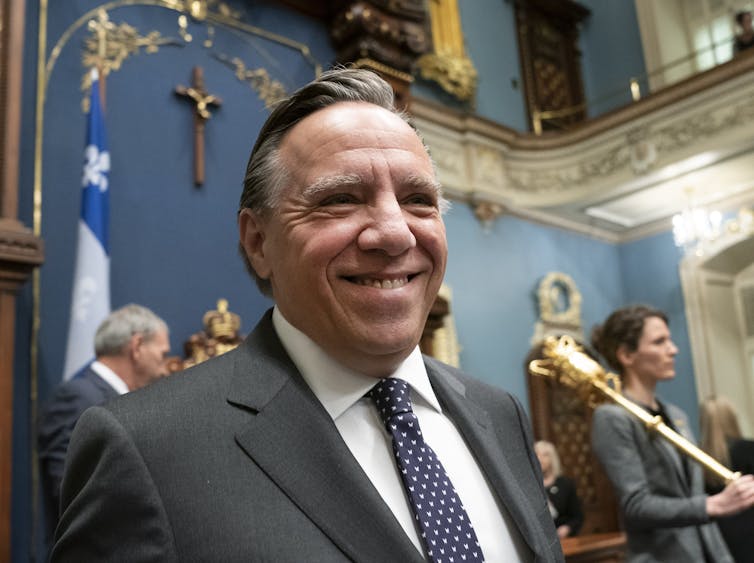Ontario Premier Doug Ford has used the Canadian Constitution’s notwithstanding clause for blatantly political purposes.
The province’s Progressive Conservative government has passed a bill limiting third-party election advertising via the use of Sec. 33 — more commonly known as the notwithstanding clause — of the Charter of Rights and Freedoms after a judge struck the law down as unconstitutional. The clause effectively allows governments to go around the Charter.
Alongside a similar incident in 2018 in which Ford pulled back from his threat to use the clause, Québec Premier François Legault has defined his political legacy through the use of the notwithstanding clause to pass his government’s secularism law.
Read more: First Ontario, now Quebec: The notwithstanding threat
That law prohibits some civil servants from outwardly displaying their religious convictions via things like the Sikh turban, Muslim hijab or Jewish Kippah and other visible religious symbols — ironic, considering the crucifix that was hanging on the wall of the province’s National Assembly until 2019.

There’s been a tradition in Québec, as well as in Alberta and Saskatchewan, of using the notwithstanding clause to avoid scrutiny under the Charter of Rights and Freedoms or to make grandstanding points against Ottawa or other political opponents.
Memorably, former Alberta premier Ralph Klein threatened to invoke the notwithstanding clause to pass legislation prohibiting same-sex marriage. That was despite the Supreme Court of Canada’s ruling that Alberta’s earlier refusal to include protections for discrimination based on sexual orientation infringed upon the Charter’s guarantee of equality rights.
Nearly a decade later, former Saskatchewan Premier Brad Wall threatened to use the clause in 2015 over a court ruling that found his government’s back-to-work legislation unconstitutional. Wall would later actually follow through on a threat to use the clause in 2017 over another adverse court ruling on the funding of Catholic schools in the province.
Despite these sporadic usages, the notwithstanding clause had no place in Ontario politics until the arrival of Ford at Queen’s Park.
Ontario: Historically not a dissenter or renegade
Unlike Québec, Canada’s original principled dissenter, or Alberta and Saskatchewan, its grumbly western renegades, Ontario has historically been the province in Confederation most concerned about buoying Ottawa and limiting its own relative power for the sake of a national project, like when former premier David Peterson offered to give up Ontario Senate seats during the Meech Lake Accord negotiations
Not Ford, however. He’s shown a propensity to disregard the traditional role of the Ontario premier in favour of aggression toward Ottawa on matters ranging from the cultural to economic. With the June 2022 provincial election approaching, this could be an attempt to avoid being judged for his handling of the COVID-19 pandemic.
The Ford government’s record is abysmal. After fumbling the response to the pandemic and repeated attempts to blame Ontario’s missteps on the federal government, Ford looks to have fastened on distraction. It’s once again based on yet another flirtation with the notwithstanding clause.

This time, the threat was levelled when the Ontario Superior Court of Justice struck down portions of the Ford government’s Elections Finance Act designed to curtail third-party election spending limits on advertising by unions. In response, Ford recalled the legislature, which had already risen for the summer, to add the notwithstanding clause to the legislation and avoid adhering to the court’s ruling — and to shield the legislation from the Charter.
Three charter provisions
How is this possible in a constitutional system that abides by the rule of law without exception? The short answer — such an assumption is a vast oversimplification of how our Constitution actually works. Few rights are truly absolute. In fact, the charter contains three provisions that permit otherwise unconstitutional legislation to remain law.
Briefly, Sec. 1 permits a balancing among competing rights, and allows a court to weigh the seriousness of a charter right infringement against the importance of what’s being pursued by the governments in question.
Sec. 24(2) exclusively pertains to evidence at criminal trials. It dictates the terms by which illegally obtained evidence can be admitted when the failure to do so would negatively impact the administration of justice.
Both of these provisions, whatever their flaws, have a clear rationale, and there’s been a subsequent deluge of case law designed to interpret them. Both sections limit the absolute quality of certain rights and require a consideration of the public interest.
But Sec. 33 is an altogether much blunter instrument:
“Parliament or the legislature of a province may expressly declare in an Act of Parliament or of the legislature, as the case may be that the Act or provision thereof shall operate notwithstanding a provision included in section 2 or sections 7 to 15 of this Charter.”
Section 2(b) of the charter, targeted by Ford, protects the “fundamental freedom” of unions to “opinion and expression.”
Going around the Charter
The notwithstanding clause, however, enables a government to go around the charter entirely, provided it declares its intent to do so in the legislation itself. Up until recently, the clause — the product of compromise during the drafting of the charter — was used only sparingly.
Read more: The history of the notwithstanding clause
However, Ford’s latest move reinforces Legault’s efforts to normalize the use of the notwithstanding clause in Canada’s two largest provinces.
This sharp departure from Ontario’s traditional role in the federation could be an issue during next year’s provincial election given it will weaken the power, prestige and sanctity of the charter — and by extension, the rule of law in Canada.

